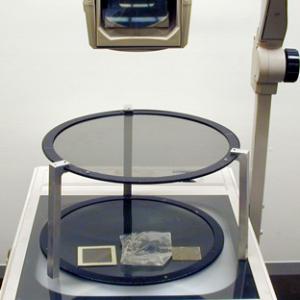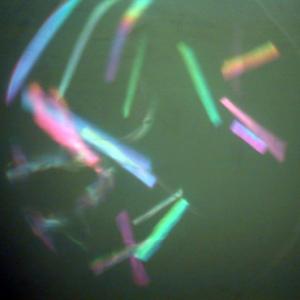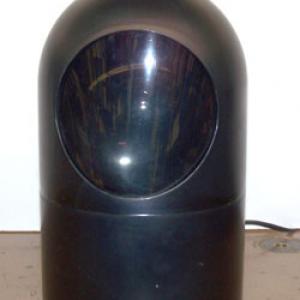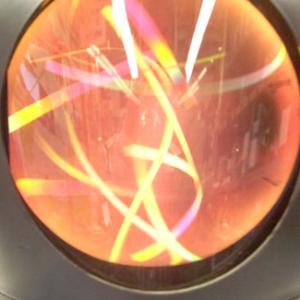College of Liberal Arts & Sciences
6H35.55 - Polarization - Cellophane
The overhead plates and equipment are used to show stress is plastics and transmission properties of different thickness of cellophane.
Place the cardboard plate on the overhead projector to block out the excess light. Place the Polarizers as indicated. Fill the Pyrex dish about 1/2 full of water and let sit overnight. This will allow the air bulbs to come out and the temperature to come to room levels. Place the stirring apparatus onto the edge of the dish. Add 2 to 3 drops of dishwashing liquid to break the surface tension of the water.
NOTE: Too much soap will cause bubbles to form. Add the cellophane strips to the liquid. Turn on the motor. The rotating cellophane in the polarized light will have a very nice effect.
NOTE: I generally let the motor run all class period as the cellophane takes a little while to start rotating from a dead start.
NOTE: The dish must be placed at the back side of the polarizing plate when on the overhead projector or you will get a rainbow across the center of the image due to the refraction of light in the water.
Turn the polarizer that is above the plate with the cellophane "flag" image. As you turn the polarizer, the flag will show the red, white, and blue colors.
- Bill Reid, "Colored Flag by Double Refraction", TPT, Vol. 32, # 1, p. 38, Jan. 1994.
- Paul Changnon, "Animated Displays IV: Linear Polarization", TPT, Vol. 31, # 8, Nov. 1993, p. 489 and referenced in Resource Letter TLC-1 Teaching Light and Color, Demonstration Experiments Resource Articles.
- G. R. Davies, "Polarized Light Corridor Demonstration", TPT, Vol. 28, # 7, p. 464, October 1990.
- G. R. Davies, "Polarized Optical Cheshire Cat", TPT, Vol. 23, # 8, Nov. 1985, p. 498.
- William R. Franklin, "The Psychedelic Student-Getter", TPT, Vol. 7, # 4, April 1969, p. 227.
- George Freier, "Erratum", TPT, Vol. 7, # 6, Sept. 1969, p. 342.
- Aaron D. Slepkov, "Quantitative Measurement of Birefringence in Transparent Films Across the Visible Spectrum", AJP, Vol. 90, #8, Aug. 2022, p. 625.
- Benjamin S. Perkalskis, "Use of Cellophane and Similar Materials as Replacement for Crystals in Demonstration of Conoscopic Pictures", AJP, Vol. 78, # 12, p. 1434, Dec. 2010.
- Pablo Velasquez, Maria del Mar Sanchez-Lopez, Ignacio Moreno, Daniel Puerto, Felipe Mateos, "Interference Birefringent Filters Fabricated with Low Cost Commercial Polymers", AJP, Vol. 73, # 4, April 2005, p. 357.
- Om-14, 15: Freier and Anderson, A Demonstration Handbook for Physics.
- O-625: "Calcite - Cellophane", DICK and RAE Physics Demo Notebook.
- O-630: "Interference with Cellophane", DICK and RAE Physics Demo Notebook.
- Bill Franklin, "Color Effects in Materials Between Polarizers", Teaching about Color & Color Vision, 1996, p. 3D-5.
- Janice VanCleave, "43, A Rainbow of Colors", Teaching the Fun of Physics, p. 68.
- "Polarized Light Mosaic", Exploratorium Science Snackbook, 78-1.
- "Polarized Light Mosaic", The Magic Wand & Other Experiments in Light & Optics, p. 85-89.
- Raymond Bruman, "Polarized Image Mosaic", Exploratorium Cookbook I, p. 25.1 - 25.3.
- Jearl Walker, "6.129, Colors and Spots and Polarization", The Flying Circus of Physics Ed. 2, p. 296.
- 5.52: Jearl Walker, "Cellophane Between Two Polarizing Filters", The Flying Circus of Physics with Answers.
- Frank S. Crawford, Jr., "Waves", Berkeley Physics Course - Vol. 3, p. 420- 450.
- Hollins N. Todd, "Polarization of Light", p. 1- 47.
- T. D. Rossing, C. J. Chiaverina, " 7.6, Wave Plates", Light Science, Physics and Visual Arts, p. 162.
- T. D. Rossing, C. J. Chiaverina, " 7.9, Applications Of Polarized In Art", Light Science, Physics and Visual Arts, p. 165.
Disclaimer: These demonstrations are provided only for illustrative use by persons affiliated with The University of Iowa and only under the direction of a trained instructor or physicist. The University of Iowa is not responsible for demonstrations performed by those using their own equipment or who choose to use this reference material for their own purpose. The demonstrations included here are within the public domain and can be found in materials contained in libraries, bookstores, and through electronic sources. Performing all or any portion of any of these demonstrations, with or without revisions not depicted here entails inherent risks. These risks include, without limitation, bodily injury (and possibly death), including risks to health that may be temporary or permanent and that may exacerbate a pre-existing medical condition; and property loss or damage. Anyone performing any part of these demonstrations, even with revisions, knowingly and voluntarily assumes all risks associated with them.




